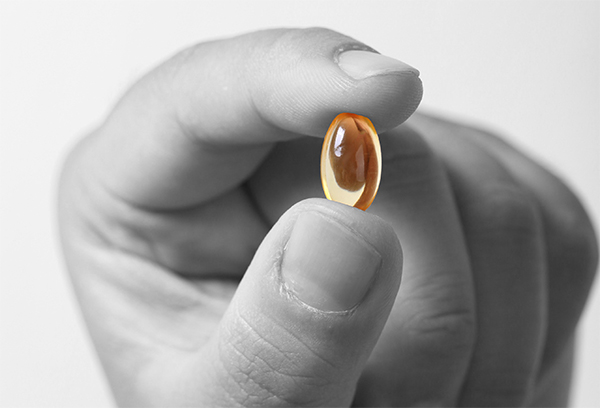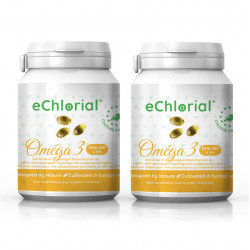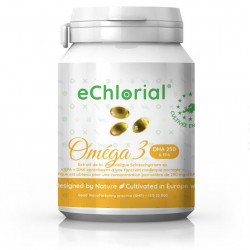What are the benefits of Omega 3 and in what foods are they found? Complete guide to Omega 3: sources, benefits, dosage, deficiencies, Organic and Vegan Omega 3…
“Omegas” are lipids, more precisely they are polyunsaturated fatty acids (PUFAs). PUFAs and in particular omega-3, omega-6 and omega-9, are involved in many physiological processes such as cardiovascular and hormonal regulation, modulation of inflammation and neuronal activity!
Go directly to your topic of interest
Browse our guides
Omega 3: In Which Foods Are They Present?
Plankton, Fish, Seeds
Omega 3s are found in all seafood such as fish, shellfish, crustaceans, as they feed on plankton.
Plankton are plant and animal. Plant plankton or phytoplankton, is composed of microalgae. Animal plankton, or zooplankton, are small animals and larvae that are the first life stages of marine animals. Zooplankton feed largely on phytoplankton, microalgae.
Plankton are the first link in our food chain, which is why they are so important!
Microalgae or phytoplankton, naturally produce omega 3. Zooplankton of which the best known is krill (small shrimp) feed on phytoplankton. The krill just like many small fish that feed on plankton. They too contain omega 3.
Omega 3s are also found in some commonly used oils, colza,soybeans… Land animal products provide varying but still very small amounts.
Omega 3s family : ALA (essential omega 3) turns into EPA which turns into DHA
Comparison Table (values in grams per serving)
| Food (serving size) | ALA | EPA | DHA |
|---|---|---|---|
| Flaxseed oil (1 tablespoon) |
7,26 | ||
| Chia seeds (28 g) |
5,06 | ||
| Nuts (28 g) |
2,57 | ||
| Cooked Atlantic salmon (85 g) | 0,59 |
1,24 | |
| Cooked herring (85 g) |
0,77 | 0,94 | |
| Sardins (85 g) | 0,45 |
0,74 | |
| Soybean oil (1 tablespoon) |
0,92 | ||
| Fatty ground beef 15% (85 g) |
0,04 | ||
| Cooked egg (1 egg) |
0,03 | ||
| Whole grain bread (1 slice) |
0,04 | ||
| Roast chicken (85 g) | 0,01 |
0,02 | |
| Skim milk (1 cup) |
0,01 |
Source : NIH Office for dietary supplement, Omega 3 Fatty Acids — Health Professional Fact Sheet
It should be noted that meat, especially beef is very low in omega-3. It is recommended to consume eggs, yogurt, microalgae, and fish (*) regularly.
(*) Warning: no fish is free of methyl mercury! It is advisable to favor small fish that contain the least amount. It should be remembered that the consumption of chlorella will protect from the accumulation of mercury in the body.
The Benefits of Omega 3
Brain and Memory (Alzheimer’s, Dementia, Cognitive Functions, Depression)
Omega 3s maintain our brains and preserve our cognitive functions! DHA is an essential component of the phospholipid cell membranes of the brain. Some scientists suggest that there is a correlation between a diet rich in omega 3 and the risk of age-related cognitive decline, Alzheimer’s disease and dementia. The results to date suggest that there should be a benefit for people with mild cognitive impairment. Omega 3 supplementation could improve certain cognitive functions such as attention, brain speed.
Further studies are needed to authorize a health claim. However experts from the European health authorities (EFSA) consider established the role of DHA in cognitive performance. They approved in 2010 to state that DHA contributes to the maintenance of good brain function.
Pregnancy
European health authority experts consider DHA to have a beneficial influence on the fetus and very young children. Maternal intake of DHA during pregnancy or breastfeeding contributes to the proper development of the child’s brain, as breast milk contains DHA. DHA also contributes to the proper development of his vision.
Thus it is recommended that pregnant women and children regularly consume fish (*) or supplement with DHA. The American Academy of Pediatrics recommends that pregnant women take 200 to 300 mg of DHA per day by consuming omega 3 rich products or via dietary supplements.
Cancer
Researchers have hypothesized that consumption of omega 3s, provided through food or dietary supplements, may reduce cancer risk due to their anti-inflammatory activity and potential ability to inhibit cell growth factor.
Skin, Osteoarthritis and Allergies
Omega 3 can improve skin problems such as those related to atopic eczema, reduce itching thus allowing the reduction of corticosteroid intake. They decrease inflammatory problems, such as joint inflammation such as arthritis, osteoarthritis but also other forms of allergies, asthma.
Rheumatoid arthritis is an autoimmune disease that is characterized by chronic inflammation of the joints. This disease is particularly debilitating because it causes chronic pain. These pains can be relieved by non-steroidal anti-inflammatory drugs, corticosteroids or other anti-rheumatoid drugs. The anti-inflammatory properties of omega-3s suggest that they may be a valuable aid in combating the effects of this disease.
Hair + Skin
Omega 3s are essential components of lipid membranes. In addition, they are anti-inflammatory constituents. A deficiency in omega-3s favors the appearance of skin problems (dryness, skin that flakes …) and sad hair. An increased consumption of marine products such as fish or / and algae, or a supplementation in omega-3s can prove to be a valuable aid for the beauty and quality of its skin and hair.
Musculation and Heart (Cardio)
Omega 3s are now clearly associated with good heart health and decreased cardiovascular risk. Health benefits have been observed as early as daily consumption of 250 mg of EPA + DHA. Epidemiological studies conducted since the 1970s have shown that populations with high fish consumption such as the Japanese or Inuit, had lower mortality rates from cardiovascular disease than other populations. Numerous studies have confirmed that omega-3s (EPA and DHA) reduce the risk of heart attack and coronary heart disease.
French, European, American health authorities .. have validated the health claim: “Omega-3 fatty acids participate in the maintenance of heart function ” as long as the daily consumption is at least 250 mg of DHA.
Weight Loss

Omega 3 supplementation would facilitate weight loss during a weight loss diet! As surprising as it sounds, lipids (omega 3) could promote weight loss or simply help with better control of one’s body mass index (BMI).
Studies conducted in 2013 by Australian researchers appear to show that omega 3s, taken as a supplement before starting a low-calorie diet, would promote the effectiveness of the weight loss regimen. Other studies indicate that omega-3 could promote lipolysis, i.e. the reaction of transformation of lipids into energy. This is interesting during a weight loss diet. To date, the results of the studies do not allow for a health claim related to the effect of omega-3 on the effectiveness of diets for weight loss.
It should be noted that while omega-3 supplementation has not yet been scientifically proven to be effective in regulating one’s body mass, a logical approach to weight control can begin with monitoring one’s respective omega-6 and omega-3 intakes. The ratio between its two polyunsaturated fatty lipids, omega 6 / omega, 3 must tend towards 5. As foods rich in omega 6 are numerous (oils ; nuts, rapeseed, soybeans, meat ..) and those rich in omega 3 are more limited (fish, seaweed ..) it is advisable to limit its consumption of fats in the kitchen.
Eyes: AMD and Dry Eye
DHA is an essential lipid constituent of the retinal cell membrane. EPA and its derivatives, may reduce retinal inflammation and have an action on its neovascularization. On the basis of these recognized effects, omega 3s suggest that they could have a protective action on the retina. The latter tends to degenerate with age, causing age-related macular degeneration (AMD). This disease represents a major cause of vision loss in the elderly.In addition, omega 3s could help people suffering from dry eyes. This problem affects more than 10% of the population. The people mainly concerned are often women at the beginning of menopause. They suffer from sometimes severe discomfort and have vision problems related to the inflammation caused by their too dry eyes. To date, even if several clinical studies have been conducted, additional results are needed to formulate a health claim that could be granted by the French health authorities.
In 2010 the experts of the European health authority (EFSA) recognize the position of scientists who argue that “DHA contributes to the prevention of vision health”
Differences between Omega 3, 6, 9?
In the Omega 6 family
In the Omega 6 family
– The essential fatty acid is linoleic acid (LA)
– Among the processing derivatives of LA: arachidonic acid
In the Omega 3 family
– The essential fatty acid is alpha linolenic acid (ALA)
– Among the processing derivatives of ALA: eicosapentaenoic acid (EPA) and then docosahexaenoic acid (DHA)
There is no possible transformation between the two omega 6 and omega 3 families.
Dosage for Omega 3 and Omega 6
Advised Philosophy
Advised dietary allowances (RDAs) according to the AFSSA report:
| OMEGA 6 | OMEGA 3 | |
|---|---|---|
| Adult Male | 10 g / day | 2 g / day (including 0.12 g of DHA) |
| Adult Female | 8 g / day | 1.6 g / day (including 0.1 g of DHA) |
| Pregnant Woman | 10 g / day | 2 g / day (including 0.25 g of DHA) |
| Nursing Woman | 11 g / day | 2.2 g / day (including 0.25 g of DHA) |
| Elderly | 7,5 g / day | 1.5 g / day (including 0.1 g of DHA) |
Data from the Martin study (2001) / ANSES report
Excess Omega 6
All omegas are good and essential for maintaining good health, but it’s a matter of making sure you consume them in the right respective proportions. Indeed, it is proved that a too important contribution in essential fatty acids omega 6 can induce an excessive competition with the essential fatty acids omega 3. The contents in omega in the current food are variable and remain mainly richer in omega 6. The latter are present in vegetable oils, mainly in sunflower and corn oils. They are found in common foods such as meats, eggs.
In its opinion of March 1, 2010, the ANSES (National Agency for Food, Environmental and Occupational Health Safety, formerly Afssa) has re-evaluated the recommended nutritional intake of lipids such as omega 3 and omega 6): they should reach 35 to 40% of the total energy intake.
It is recommended that adults consume no more than five times as much omega 6 (LA) as omega 3 (DHA), or an “omega 6 to omega 3” ratio of about 5. In reality the average ratio is often higher than 10, or even more like 15, which is far too much!
Dangers of Omega 3 deficiencies
Caracteristics
The first consequences of omega 3 deficiencies are seen on the skin. This is dry, rough, flaky and susceptible to all kinds of dermatitis.
The limiting concentration of essential fatty acids such as omega 3s has not been defined. It has been observed that their deficiencies may cause vision problems, decline in brain function and may account for a greater susceptibility to disease due to poor immune conditions.
Health authorities encourage the promotion of foods that naturally contain omega 3 and want manufacturers to fortify their products with it.
Which brand to choose and where to buy it ? Pharmacy, organic stores, Internet ?
Omega 3 Organic
Are there certified Organic Omega 3s? Today the answer is NO, there are no certified Organic Omega 3s. You will often find the title “Omega 3 certified organic” on an online ad but arrived on the page in question the organic certification will have disappeared… Failing an “Organic” label, choose a natural product that provides maximum information on its origin.
Health authorities are considering evolving their organic certification field to “organically grown” to microalgae extracts as it was able to position itself in 2017 to allow organic certification to microalgae.
Omega 3 Vegan
The omega 3 proposed on the market of food supplements are mainly extracted from animal flesh, fish oil or Krill in variable dosages of EPA and DHA. On average animal oils concentrated in omega 3 contain 75 mg of EPA and 45 mg of DHA per capsule of 500 mg for Krill oil, against 90 mg of EPA and 60 mg of DHA for fish oils.
New: supplements made with vegan Omega 3 microalgae (Schizochytrium) extracts are now offered.
Omega 3s extracted from seaweed are a welcome replacement for dietary supplements extracted from krill oil or fish.
In effect:
- They are 100% plant-based, taken directly from the source, i.e. from the microalgae that serve as food for krill and small fish. It is by consuming them that they have enriched their flesh.
- The yields of omega 3 extractions from animal oils still need to be optimized, even if they have been considerably improved over the last twenty years.
Omega 3s extracted from microalgae can contain up to 250 mg of omega 3 (DHA) per capsule.
We recommend that you always check the composition of the capsules and make sure they are certified “vegan” as most capsules use animal gelatin.
Echlorial will soon offer 100% vegetable capsules of omega 3 extracted from microalgae containing 250 mg of DHA. 1 capsule per day will help maintain normal vision, normal brain function and contribute to the normal function of your heart.
Vegan Omega 3

In what form should I take Omega 3: capsules, liquid, other?
When to take Omega 3: morning, noon or night?
Dangers, Contraindications and Side Effects
European health authorities consider it safe to supplement with EPA + DHA at more than 5 g per day.
High doses
It should be noted that high doses of omega 3s may have been observed:
– + 900 mg/day of EPA or/and + 600 mg of DHA for several weeks, may reduce immune function due to their anti-inflammatory actions.
– Up to 15 g per day of EPA or/and DHA for several weeks may promote bleeding due to their impact on platelet aggregation.
However, an increase in bleeding time associated with high intakes of omega-3 fatty acids had been reported, with a potential risk of bleeding complications. Clinical studies show that although bleeding time is increased, this increase does not appear to substantially influence the risk of bleeding in the general population. Importantly, the effect demonstrated on platelet aggregation is significantly less than that observed in aspirin-treated individuals.
It may also be noted that in intervention studies, doses of the order of 1 g/d of EPA-DHA were administered for prolonged periods of time without serious adverse effects being reported. However, the longest studies are limited to a few years.
In the AFSSA report “Omega-3 Fatty Acids and the Cardiovascular System,” nutritional value and claims (referral 2001-SA-0104), it is stated that high levels of EPA-DHA could be administered over a prolonged period of time without serious adverse effects being reported. However, the longest studies are limited to a few years.
U.S. health authorities (FDA) recommend no more than 3 g/day of EPA and DHA combined with more than 2 g/day of nutritional supplementation. However, these limitations are largely exceeded in clinical trials.
Vegan Omega 3

